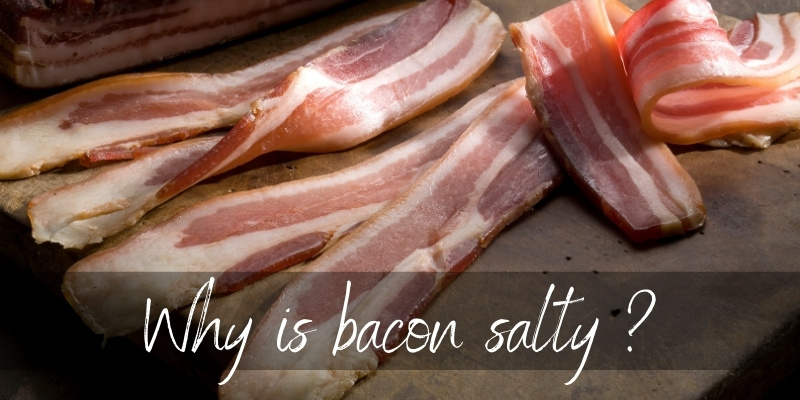Bacon is treasured for its smoky, salty, umami flavor that enhances everything from breakfast to burgers. However, the high sodium content can be off-putting for those limiting their salt intake. Thankfully, it’s possible to remove some of the salt from bacon through simple soaking and rinsing techniques.
Why is Bacon So Salty?
To understand how to desalinate bacon, it helps to know why it’s so salty in the first place. There are a few reasons behind the high sodium levels
-
Salt is used to cure bacon – it draws moisture out, inhibits bacteria, and gives bacon its signature salty taste
-
Salt enhances flavor. Sodium amplifies the smoky, savory notes of the pork.
-
Bacon needs salt for food safety Curing with salt preserves and extends shelf life
-
Salt firms up texture. It extracts water to give bacon a pleasant crispness.
With salt being so integral to creating bacon’s distinctive flavor, texture and preservation, it’s no wonder that a 2-slice serving can contain over 350mg of sodium.
Health Concerns of a High Salt Diet
While delicious, too much sodium from foods like bacon can be problematic for heart and vascular health. The more salt you consume, the higher your risk of:
-
High blood pressure – sodium causes blood vessels to constrict, raising blood pressure.
-
Stroke and heart disease – high blood pressure damages arteries over time.
-
Fluid retention – excess salt makes the body hold onto water, leading to bloating and swelling.
-
Kidney problems – kidneys work overtime to filter out excess sodium.
-
Stomach cancer – linked to frequent intake of preserved, salty foods.
To avoid these health issues, the American Heart Association recommends no more than 2,300mg of sodium per day. Moderating bacon can help reduce average daily sodium substantially.
Effective Techniques to Remove Salt from Bacon
If you love bacon but want to control your salt intake, these methods can help cut down the sodium:
Soak It Out
Soaking bacon in cold water helps draw out the salt through natural osmosis.
-
Place raw bacon in a container and cover completely with cool, fresh water. Use enough water to submerge the meat.
-
Let soak for 1-2 hours, up to overnight for maximum salt removal.
-
Rinse bacon under cool water after soaking. Pat dry with paper towels before cooking.
-
Repeat the soak and rinse if bacon still seems too salty.
Parboil and Drain
A quick parboil helps leach out salt from bacon for easier rinsing.
-
In a pot, bring water to a boil. Add raw bacon and parboil for 1 minute only.
-
Drain hot water and rinse bacon with cool water. Rub gently to wash away surface salt.
-
Pat bacon dry thoroughly with paper towels. Finish cooking as normal.
Cook Low and Slow
Gently cooking bacon over lower heat for longer draws out fat and salt before it crisps up.
-
Place raw bacon strips in a cold skillet. Heat skillet over medium-low.
-
Cook bacon slowly for 10-15 minutes, turning occasionally.
-
Drain on paper towels when done. The bacon will render out more salty fat.
Bake It
Baking bacon on a wire rack set over a foil-lined pan allows fat and salt to drain away freely.
-
Preheat oven to 400°F. Arrange raw bacon on a wire rack set on a baking sheet.
-
Bake for 15-20 minutes until crispy. Rotate rack and drain fat as needed.
-
Blot cooked bacon on paper towels to soak up grease and residue.
Tips for Reducing Bacon’s Sodium
In addition to desalting techniques, there are other helpful ways to curb bacon’s saltiness:
-
Opt for center-cut bacon which is lower in sodium than regular sliced bacon. Or choose lean turkey bacon.
-
Mix regular bacon with an equal amount of turkey bacon for a less salty combo.
-
Substitute smoked paprika when cooking veggies, eggs etc. to mimic bacon’s smoky taste without the salt.
-
Crumble small amounts of bacon as a flavoring instead of eating whole slices. A little goes a long way.
-
Avoid cooking methods like frying in oil or salting while baking – they add even more sodium.
-
Balance bacon’s saltiness by eating it with fresh, low-sodium foods like vegetables, fruits and whole grains.
Make Your Own Low-Sodium Bacon
For complete control over the sodium level, make DIY bacon from pork belly or loin. You can customize the cure to minimize salt.
A basic dry cure contains:
- 1 cup brown sugar
- 1/2 cup kosher salt (can reduce to 1/4 cup)
- 2 tbsp. curing salt (nitrites)
- Spices like black pepper, juniper berries, etc.
Combine cure mix and generously coat pork. Refrigerate 3-10 days. Rinse, rest, and slice pork into bacon. Lightly smoking adds extra flavor. Homemade bacon lets you season to your taste and avoids excess salt from mass manufacturing.
Enjoy the Smoky Pork Flavor Minus the Salt
With some easy desalting tricks, you can keep enjoying delicious bacon without derailing your low-sodium diet. A short soak in cold water, gentle parboil, slow cooking method, or DIY bacon gives you all the rich, savory flavor you love while controlling excess salt. Reduce your intake of this sodium-heavy food and put your health first while still indulging in moderation.

What if your bacon is too salty?
FAQ
Does washing bacon remove salt?
How to remove salt from cured meat?
What does soaking bacon in water do?
